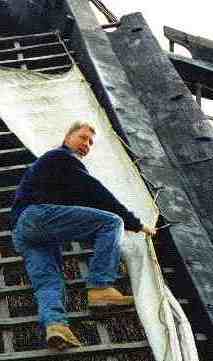[From Bath, Netherlands we rode along the coast via Delft, where we stopped off for a few days. All the way to Alkmaar, the first twin, we enjoyed the seaside scenery of the LF1 cycle route.]
Alkmaar is Bath’s twin in north Holland. The twinning started after the war when a fundraising project in Bath donated a thousand pounds to the Dutch city, then recovering from the effects of Nazi occupation. You can see the fundraisers’ barrel organ which was played round Bath in Alkmaar’s magnificent city hall today.
Alkmaar is reminiscent of Amsterdam with its canals, brick-covered streets, trim gabled houses lining the waterfront, and drivers performing improbable feats of parking tight against the unfenced drop down the canal and still managing to open the door and get out without getting wet feet.
After two weeks of camping, the Hotel Heiloo in Heiloo, a few km south, was an extraordinary luxury – a real treat to have proper baths instead of rushed showers trying to guess when the token will run out. The satellite TV was good too, with Rob having the bewildering choice of watching the UEFA Cup Final on the BBC, Dutch, German, Italian, or Moroccan TV.
Alkmaar’s cheese market was on the Friday, and the tourists were out in force.
Basically an unconscionable number of cheeses are laid out in the market square, a few traders slap hands like masons doing high-fives, and lots of chaps in morris-dancer outfits run around carrying them on toboggans on shoulder straps. Great fun, and thoroughly recommendable.

On one corner of the square, by the 17th century old town hall (picture), there’s Bathbrug (Bath Bridge) leading into the old town. And there’s lots of old town to explore, with narrow cobbled streets dating back to the middle ages, shops promising ‘herbal remedies’ (I don’t understand that), the best stocked cycle accessory shop I have ever seen, and tons of pavement cafes – a shade bigger than Bath with a more cosmopolitan feel.
Cycle paths are everywhere of course – even the mayor cycles to work here! Not because they think bikes are quaint or nice, but because it’s the fastest way to get around. The superb network of cycle paths – a system all to itself, with its own road signs and traffic lights – and the fact that cars give way to bikes not vice versa, helps. The fact that Holland is flat is less of a help than you might think – it’s also very very windy, and whereas a hill has a downhill sooner or later, a headwind can last all day and then turn round spitefully when you do.
Holland is a surprisingly good place to eat too. Think Britain has the monopoly on fish and chips? You’ll get delicious freshly fried fish from the market stalls for three guilders – under a pound – and the batter is, I’m afraid to say, far lighter and tastier than a lot of soggy English stuff you get that’s been sitting under the lights for half an hour. And chips (from a separate stall) are in the Belgian mould, with mayo, freshly fried for you, and irresistible. Then there’s the pancakes (light and delicious with all sorts of savourty and sweet fillings – and syrup even on the savoury ones!) the poffertjes (tiny bite-sized breakfast pancakes) and stroopwafeln (waffles with that lovely syrup again). Oh, and lots of good beer and cheap wine (half the price in the supermarkets that you pay in England). It’s a good job the Netherlanders cycle so much or they’d all be fat enough to sink the sightseeing boats that ply Alkmaar’s canals.
Add some nice beaches just a half-hour cycle ride from Alkmaar, a few bulb fields (in the sense of Saudi Arabia having a few sand dunes) and you have a great place.
People are friendly and generous, everyone speaks at least some English, and they have a very good sense of humour very much on English lines. In fact, they all watch Have I Got News For You and Never Mind the Buzzcocks on cable TV, and even some TV ads are in English.

We explored some of the surrounding countryside with the local cycling club – thanks Robert Boek and the Alcmaria Victrix boys – and looked round one of the extraordinary pumping windmills, still going after 365 years, that helped to drain the marshes and seas and create new land for farming.
Jan van Diepen, one of the millers, is the guy climbing up the windmill paddles here. Much of northern Netherlands is several metres below sea level – and below the canals that drain them – and has to be pumped continuously. Now electric pumps do most of the work, but when the computers hiccup or there’s heavy rain, the old mills are on standby to help out.

Many many thanks to Hanneke and all at the Municipal Office of Alkmaar for being so generous and enthusiastic and making our visit a joy (we ended up staying an extra two days). We look forward to coming back in 2004 for the 750th anniversary celebrations of Alkmaar. And to show the Twinning concept extends far and wide, the weekend after we left, there was a football team from Chipping Sodbury. Makes a change for footballers to be coming into the Netherlands: most of their stars can’t leave quick enough to escape the high rate of taxation. Half the Barcelona team is Dutch…